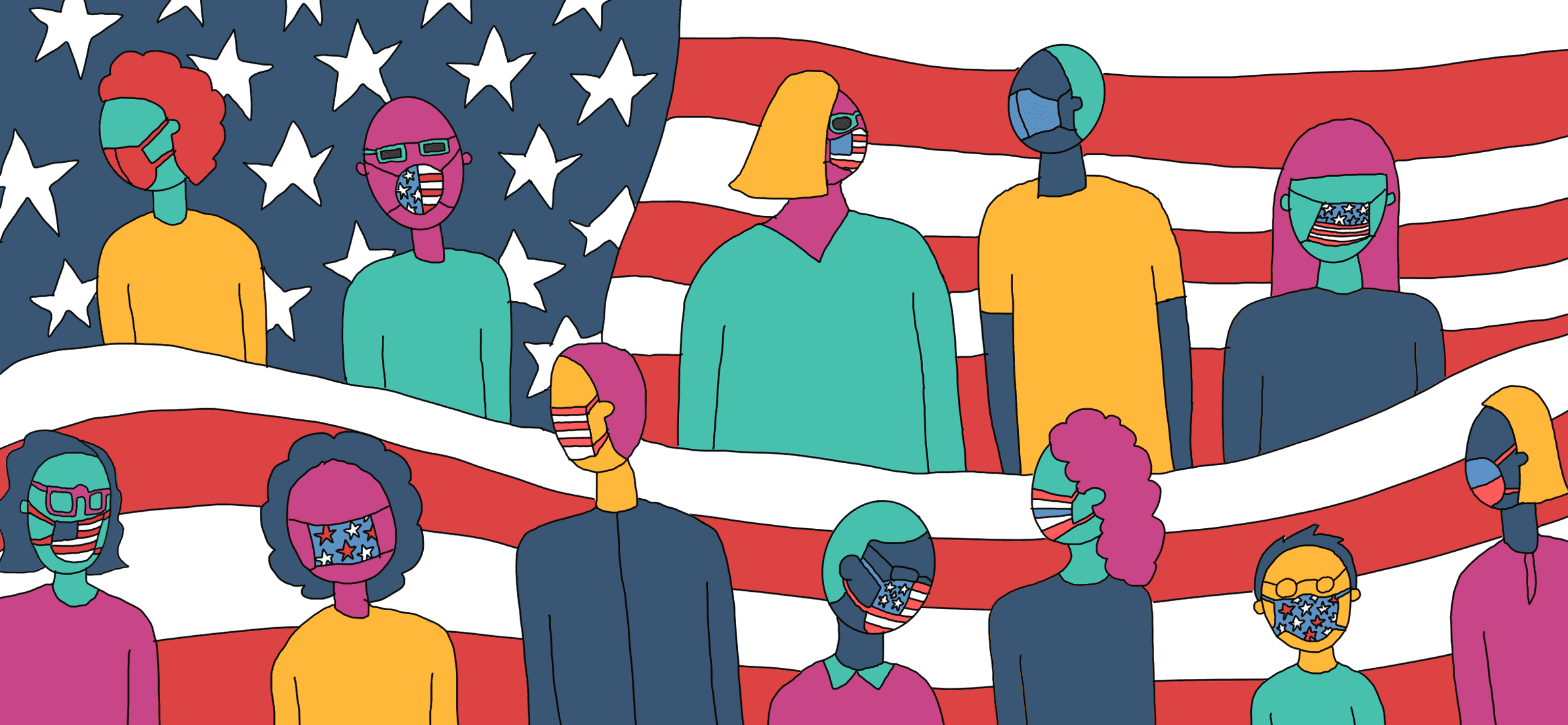
When the history of this period is written, it will feature one of the most important branding and marketing opportunities in American history: the humble face mask. Never has such a simple object contained so much potential for positive change — and yet fallen so short in its initial execution. Thankfully, we still have time to change that history. But it’s running out fast.
Our issue isn’t technological; the physical makeup of a mass-market face covering is essentially the same as the influenza edition from 1918. Nor are we logistically constrained, having fabricated and distributed far more sophisticated materials in the past. We have supply, demand, and distribution covered, all at a feasible cost for nearly everyone.
What’s missing is the sell — enabled by the time-honored tenets of branding and marketing. Like any product, the mask requires a concise framing of the problem at hand, compelling evidence that it’s solvable, and reinforcement of the solution’s unique value through clarity and repetition. In layman’s terms, it needs a persuasive case, a great story, and a bold campaign — all conveyed simply and memorably.
Despite what some of our industry colleagues might imply, these techniques are not rocket science — though they did work splendidly when our forebears sold the space program last century. Nor are they applicable only to national objectives — just ask the global spread of fascism decades earlier. Flash back far enough and even King George III might have a few choice comments on their efficacy.
But our current challenge has arrived with a significant wildcard. Whenever this country has accomplished something massive, from vanquishing existential threats to walking on the moon, we’ve done so with clear, consistent direction from the top. Absent that, it’s now clear that whatever our political leanings, we citizens must now fight this battle on our own. And this simple cloth mask may be our sole weapon for survival.
Can Americans all agree to put it on — so we can pull this off?
Imagine an alternate reality with best practices applied. Our shutdown occurs as planned, but the nation’s best and brightest spend our hard-earned downtime establishing a national pandemic strategy. It’s a science-based, data-driven plan with all the fixings — testing protocols and supplies, contact tracing systems, protective equipment for healthcare workers, the whole shebang.
Working in parallel — equipped with plenty of advance notice, time, and money — the United States charts a post-shutdown course of action for her citizenry. Hand-washing is an easy enough message. Physical distancing requires a bit more education, but it’s manageable — particularly with the foresight to reframe it without the word “social.”
The third leg of the stool presents a paradox, however, since it seems both simple and counterintuitive: a piece of virtually any cloth that covers the nose and mouth and attaches to the head. Sure, wearing one feels like a minor inconvenience at first, but it’s cheap and easy for everyone — and most importantly, it’s proven to work.
This is where the branding begins: making a clear argument. When we emerge from lockdown, says the government, here’s the deal. This virus is deadly, but a mask protects you and others effectively. Wear it any time you can see another person while away from home, whether indoors or out. If we all do this, without exception, we will emerge victorious in a few weeks.
Finally, the critical icing upon our crisis cake: This is your patriotic duty. Let’s show the world who we are.
Notice the precision of the case. It offers no excuses and leaves no wiggle room. It connects specific actions with a direct result. And it transcends politics, relying instead on our shared binding agent across the ideological spectrum: love of country.
Yes, we Americans are an unruly bunch, born by revolution and baptized in conflict. We often practice our birthright of freedom with more self-interest than collectivism. But across every crisis where our government has asked for national sacrifice to ensure our survival, we’ve emerged undefeated. Battered, certainly, and not always fully aligned — but still victorious.
Our nation’s visual brand system is well-defined, even if a few elements are outdated. So in this alternative reality, public and private sectors unite in marketing our patriotic duty with a war footing. In the weeks before our grand re-opening, all residents are provided with masks, free of charge, emblazoned with stars and stripes and delivered with pride by the postal service.
The masks debut simultaneously from coast-to-coast, championed in unity by leaders of both parties. A new flood of patriotic imagery makes our post-9/11 days seem subtle. The American face covering becomes this century’s victory garden — a chance to do our part for each other, and a reminder that collective triumph is borne of individual sacrifice.
The campaign rolls on in the weeks ahead, led by Uncle Sam and echoed by every commercial brand seeking a halo. Our collective action yields a stream of daily data that tracks our success against the rest of the world — an inverse version of Vietnam’s nightly body count. It’s working, says the messaging. We’re in this together, and victory is nigh.
Again: clarity and repetition. In capable hands, those narrative principles helped power a revolution and resolve global conflicts. They rallied a nation to touch the stars and defeat a nuclear adversary. They can work, but only if you work them.
The scenario described here may have sprung from an alternate reality, but its core story remains true. If we’d all worn masks, without exception, we’d likely have emerged victorious months ago. And while we didn’t experience this narrative in real life, its closing line is undeniable. We’ve definitely shown the world who we are.
Yet while America may be down, she’s not out. Even though our officials initially confronted this challenge with mixed signals, we the people now have a second chance to take it on — this time, collectively. By many expert projections, we may not get a third.
Where we’ve lost time — and with it, lives and treasure — we’ve gained data. Unlike the pandemic’s early stages before scientific consensus formed, each day now presents a clearer picture of how the virus operates and how it might be contained. We can learn as much from relative success stories like South Korea as we can cautionary tales like Brazil.
Beyond the numbers, though, America has experienced two especially powerful data points in recent months. When millions took to the streets in the name of George Floyd, responsible masking led to no clear increase in infections. Yet an indoor gathering in Tulsa without masks resulted in a spike. We were all witnesses to both.
So slowly, the tide of public opinion has started to shift. As the pandemic has expanded, governors across the South and West have begun touting the virtues of mask-wearing by their constituents, many strengthened by fresh legal mandates. Companies have instituted more aggressive standards than required, across a spectrum of brands from Starbucks to Walmart.
And while such top-down efforts are vital, bottom-up measures are just as important. Epidemiologists say that a critical mass of collective action often arrives once the abstract becomes personal. As numbers spike, more Americans are in direct contact with the people afflicted. For many of us, a faceless number is one thing, but a friend or relative quite another.
Once the crisis becomes real to enough people, we’ll all be reminded of the serious side of liberty’s equation — that freedom isn’t free. In the spirit of collective sacrifice, we’ll need to summon a sense of forgiveness. Even if we first treated the issue in conflicting ways — whether informed by virtue signaling or philosophical defiance — it’s now time for our commonalities to outweigh our differences.
In more ways than one, we all need to give each other cover.
Hopefully that bit of grace offers a silver lining to the storm clouds of our current situation. The more we align as citizens around a single outcome, the more likely we can have honest conversations about our obligation to each other — regardless of our party, age group, ethnic background, or socioeconomic status. Maybe we’ll finally talk meaningfully about self-discipline, collective safety, and yes, even patriotic duty.
Like it or not, our initial window of response has closed. But now, on the cusp of round two, perhaps we Americans will take the initiative to reshape our narrative — while we still can.


